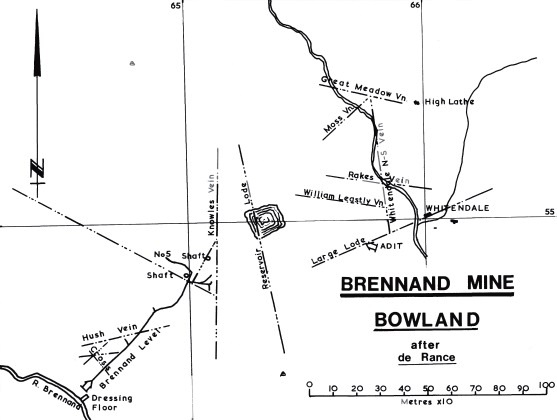 |
Northern Mine Research Society Registered Charity 326704 |
Brennand Mine
 |
From British Mining No.33 © MC Gill |
The mine seems to have been idle until 1865, when workmen, who were cutting drains, discovered lumps of lead ore. The Whitewell Mining Company Ltd was floated in January 1866 and the mine was leased from Colonel Towneley, of Burnley.
A trial pit in Far Pasture Clough in the area of the Engine Shaft found the vein, which was said to be four feet wide, and contained "fine stones of lead, embedded in a beautiful matrix". Brennand Level was driven from near the beck at Brennand House and cut the vein at the Fifth Level near the Engine Shaft, at depth of 34 fathoms. The Top or First Level was driven onto the vein from the surface near the Engine Shaft, where the Second, Third and Fourth Levels were driven at depths of about 7, 16 and 25 fathoms. The vein followed the axis of the Sykes anticline and ore was found in the Red Beds Limestone, especially around its junction with the massive shales which stopped further mineralisation.
Output began to fall off in 1871, which was also a time of low lead prices, and the company agreed to give the mine up in August 1874. In its nine years of life the Whitewell Mining Co. produced about 2000 tons of ore, which was dressed at the mouth of Brennand Level. Zinc blende was also present in the veins, but no record of its being worked has survived.
For further information please see:
- Gill, M.C. The Yorkshire and Lancashire Lead Mines: A study of Lead Mining in the South Craven and Rossendale Districts (British Mining No.33, 1987)